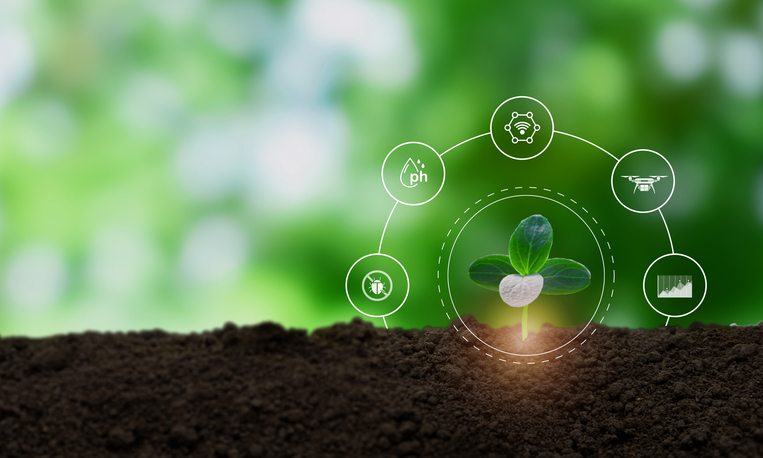The agricultural industry is rapidly transforming, with technology playing a crucial role in enhancing efficiency, sustainability, and productivity. Among the most innovative technologies reshaping the field is the concept of digital twins. While traditionally associated with manufacturing and aerospace, digital twins are now making their mark in agriculture, offering unprecedented insights and optimization capabilities. But what exactly are digital twins, and how are they being used in AgTech? Let’s dive into this cutting-edge technology and explore its potential in modern farming to understand digital twins and their future in smart farming.
What Are Digital Twins?
A digital twin is a virtual representation of a physical system, object, or process. It serves as a dynamic model that reflects the real-world counterpart in real-time, allowing users to simulate, monitor, and analyze performance without physical intervention. The concept originated in industries where precision and efficiency are critical, such as aerospace and automotive manufacturing, where digital twins are used to simulate complex systems and predict outcomes under various conditions.
In agriculture, digital twins offer a similar level of control and insight, but they are applied to farming operations, crops, and even entire ecosystems. By creating a digital replica of a farm, farmers and researchers can simulate different scenarios, predict outcomes, and make data-driven decisions that optimize resources, reduce waste, and increase yield.
How Digital Twins Are Used in AgTech
Digital twins are gradually becoming a powerful tool in AgTech, offering farmers and agricultural businesses new ways to optimize their operations:
- Field Trials and Crop Management:
- One of the most significant applications of digital twins in agriculture is in field trials. Traditionally, developing and testing new crop varieties or agricultural products is a time-consuming and expensive process. Digital twins allow for the virtual testing of crops under various conditions, significantly reducing the need for physical trials. This not only saves time but also cuts down on costs, making it easier and faster to bring new products to market.
- Farmers can use digital twins to model how different crops will perform under varying conditions, such as changes in climate, soil quality, or irrigation levels. By simulating these scenarios, they can make informed decisions about which crops to plant, when to plant them, and how to manage them throughout the growing season.
- Predictive Analysis and Resource Optimization:
- Digital twins are particularly valuable for their predictive capabilities. By integrating real-time data from sensors and IoT devices, digital twins can forecast future conditions, such as weather patterns or pest outbreaks, and provide actionable insights on how to respond. This allows farmers to anticipate challenges before they occur and take proactive measures to mitigate risks.
- Resource optimization is another critical area where digital twins excel. By simulating various irrigation strategies or fertilization schedules, farmers can determine the most efficient use of resources, reducing waste and enhancing sustainability. For example, a digital twin can help decide the precise amount of water or nutrients a crop needs at different stages of growth, ensuring that inputs are used efficiently and effectively.
- Farm Operations and Automation:
- Beyond crop management, digital twins can be used to optimize entire farm operations. From machinery maintenance to labor management, the technology can simulate various operational scenarios, helping farmers streamline processes and reduce downtime.
- The integration of digital twins with automation technologies further enhances their utility. Automated systems, such as irrigation controllers or robotic harvesters, can be guided by insights generated by digital twins, ensuring that they operate at peak efficiency and respond to real-time changes in the farming environment.
Benefits of Digital Twins in Agriculture
The benefits of digital twins in agriculture are manifold:
- Cost Reduction: By reducing the need for physical trials and optimizing resource use, digital twins can significantly lower operational costs.
- Increased Efficiency: Digital twins enable farmers to make data-driven decisions that enhance productivity and reduce waste.
- Enhanced Sustainability: By optimizing inputs like water and fertilizers, digital twins contribute to more sustainable farming practices.
- Risk Mitigation: The predictive capabilities of digital twins allow farmers to anticipate and prepare for challenges, minimizing potential losses.
The Future of Digital Twins in AgTech
As digital twins continue to evolve, their applications in agriculture are expected to expand and show first-hand digital twins and their future in smart farming. Future developments may include more sophisticated integration with AI and machine learning, enabling even more accurate predictions and deeper insights. Additionally, as more data becomes available, digital twins will become increasingly precise, further enhancing their value to farmers and agricultural businesses.
AgriLynk: Leading the Way in AgTech Innovation
While AgriLynk may not currently use digital twins directly, our commitment to harnessing advanced technology to revolutionize farming is unwavering. Just as digital twins represent the cutting edge of technological innovation, so does AgriLynk with its advanced wireless monitoring and control systems. Our platform empowers farmers with real-time data, enabling them to make informed decisions that enhance productivity and sustainability. By providing farmers with the tools they need to manage their operations efficiently, AgriLynk is proud to be a forward-thinking leader in the AgTech industry.
At AgriLynk, we believe in the power of innovation to drive the future of agriculture. As technologies like digital twins continue to transform the industry, AgriLynk remains dedicated to supporting farmers in their journey toward smarter, more efficient farming practices. Join us as we lead the way in AgTech innovation and explore how our solutions can help your farm thrive. Call one of our real, live, incredibly helpful staff who’s based in Southern California at 760-1529 or Contact Us for more information.

